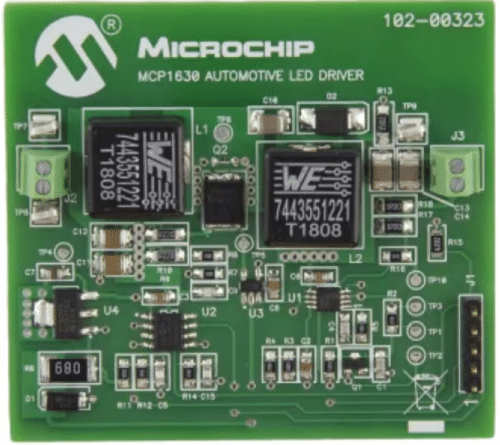With this step-up/down, switch-mode DC-DC converter, the LED lighting solution is designed for efficiency and reliability in automotive environments.

The need and importance of SEPIC Automotive LED Drivers are paramount in today’s automotive industry. These drivers offer high-efficiency lighting solutions capable of handling step-up and step-down operations, essential in the fluctuating voltage conditions typical of automotive environments. Their compact design allows easy integration into tight spaces, while their robustness ensures reliability under high-voltage stresses and harsh vehicle conditions. SEPIC LED drivers contribute significantly to safety by providing consistent and reliable illumination, enhancing visibility for drivers and pedestrians. The MCP1630 SEPIC automotive LED driver reference design from Microchip is a versatile step-up/down, switch-mode, DC-DC converter designed for LED applications.
The demo board delivers a constant current source of 350 mA, which can be increased to 700 mA with hardware modifications. Other output currents can also be achieved by adjusting the values of board components. Engineered to withstand the high-voltage peaks typical in automotive environments, the SEPIC automotive LED driver reference design offers valuable insights into typical high-voltage automotive applications.
At the heart of this design is Microchip’s MCP1630, a high-speed, pulse-width modulator (PWM) device housed in an 8-pin package. It integrates all necessary analogue components for a peak current switch-mode control loop, including an error amplifier, PWM comparator, and high-current driver output pin. An external clock source controls the switching frequency and maximum duty cycle of the MCP1630.
A PIC12F683 microcontroller, also in an 8-pin package, generates a 330 kHz switching clock for the MCP1630. Additionally, the PIC12F683 firmware monitors input and output voltages and can optionally dim the LEDs when a button is connected. The MCP1630 operates in peak current mode control within a SEPIC power train circuit in this reference design. To accommodate duty cycles exceeding 50%, a ramp generator supplies an extra reference signal to the design for slope compensation.
The reference design boasts several notable features. It has a compact size with high output power and can operate in both Buck (step-down) and Boost (step-up) modes. The design sustains voltage stresses typically found in automotive products, enduring 42 VIN for 180 ms, and maintains high efficiency over the entire operating input and output voltage ranges, with a typical efficiency of 85%. It provides a maximum output current of 350 mA, which can be adjusted with minor hardware modifications, and a maximum output power of 18W. The driver offers optional software dimming control via PWM and current modes and includes preprogrammed source code. The switching frequency, maximum duty cycle, and the MCP1630 reference voltage are all adjustable through firmware, allowing for additional application functions to be implemented.
Microchip has tested this reference design. It comes with a bill of materials (BOM), schematics, assembly drawing, printed circuit board (PCB) layout, etc. You can find additional data about the reference design on the company’s website. To read more about this reference design, click here.












